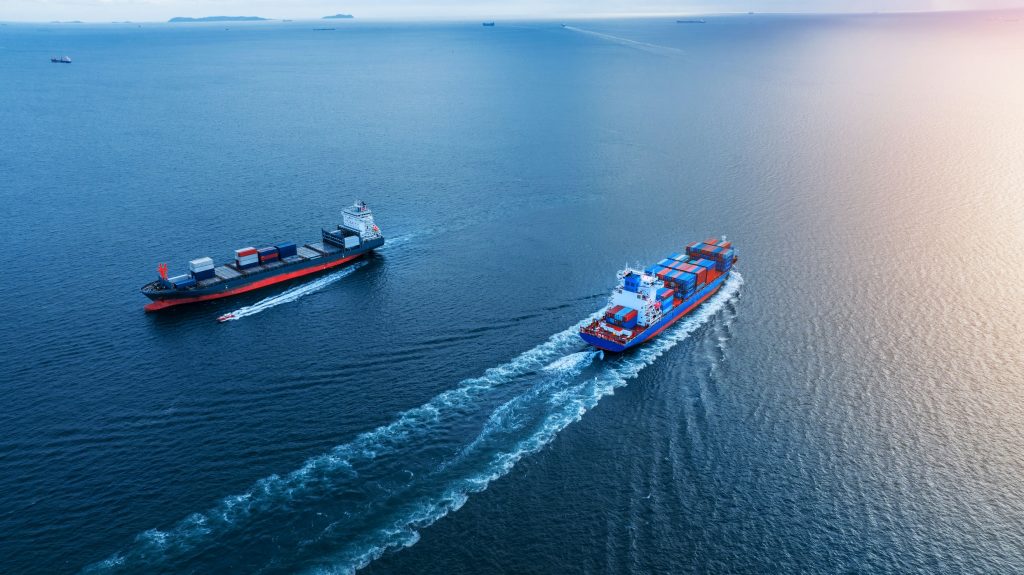
Sea / River Type General Cargo / Container Vessel
General Cargo, known as breakbulk, is usually on pallets or in bags. There may be specialised handling facilities for such cargo, but usually loading and unloading is carried out using cranes and straps (for boxes) or slings (for bags). These vessels can also carry loose and irregular cargo, in which case the vessel’s crew and port stevedores pack the cargo to minimise damage and maximise space.
Although largely replaced by bulk and container carriers, general cargo vessels still operate throughout the world.
Container Vessels
Containers have become the main way of transporting manufactured goods around the world. A container can be transferred between truck, train and ship relatively easily and is a standard size to simplify transportation. Containers can accommodate anything from foodstuffs to electrical equipment to automobiles. They are also used to transport bagged and palletised goods, as well as liquids and refrigerated cargo.
Standard containers are measured as TEUs (Twenty-foot Equivalent Units) and are generally 20 feet (1 TEU) or 40 feet (2 TEUs) long. All standard shipping containers are 8 feet wide and 8 feet 6 inches tall. There are also longer, taller and even shorter standard sizes, but these are less common.
Container ships are made up of several holds, each equipped with “cell guides” which allow the containers to slot into place. Once the first layers of containers have been loaded and the hatches closed, extra layers are loaded on top of the hatches. Each container is then lashed to the vessel but also to each other to provide integrity. Containers are usually loaded by specialised cranes or even general purpose cranes with container lifting attachments. Some small container vessels are geared to allow self-loading and discharging.
Container vessels are used predominantly on liner routes and are some of the biggest vessels afloat. Ultra Large Container Vessels (ULCVs) such as the Emma Maersk (lead ship of the Maersk E-Class vessels) are able to carry approximately 15,000 TEU (depending on container weight). Large container vessels are restricted by their size to certain ports around the world and are also unable to transit certain areas due to draft or, in the case of canals, beam restrictions.
Containers have become the main way of transporting manufactured goods around the world. A container can be transferred between truck, train and ship relatively easily and is a standard size to simplify transportation. Containers can accommodate anything from foodstuffs to electrical equipment to automobiles. They are also used to transport bagged and palletised goods, as well as liquids and refrigerated cargo.
Standard containers are measured as TEUs (Twenty-foot Equivalent Units) and are generally 20 feet (1 TEU) or 40 feet (2 TEUs) long. All standard shipping containers are 8 feet wide and 8 feet 6 inches tall. There are also longer, taller and even shorter standard sizes, but these are less common.
Container ships are made up of several holds, each equipped with “cell guides” which allow the containers to slot into place. Once the first layers of containers have been loaded and the hatches closed, extra layers are loaded on top of the hatches. Each container is then lashed to the vessel but also to each other to provide integrity. Containers are usually loaded by specialised cranes or even general purpose cranes with container lifting attachments. Some small container vessels are geared to allow self-loading and discharging.
Container vessels are used predominantly on liner routes and are some of the biggest vessels afloat. Ultra Large Container Vessels (ULCVs) such as the Emma Maersk (lead ship of the Maersk E-Class vessels) are able to carry approximately 15,000 TEU (depending on container weight). Large container vessels are restricted by their size to certain ports around the world and are also unable to transit certain areas due to draft or, in the case of canals, beam restrictions.

